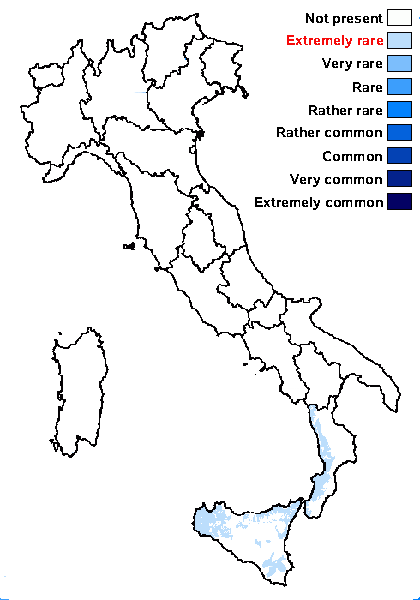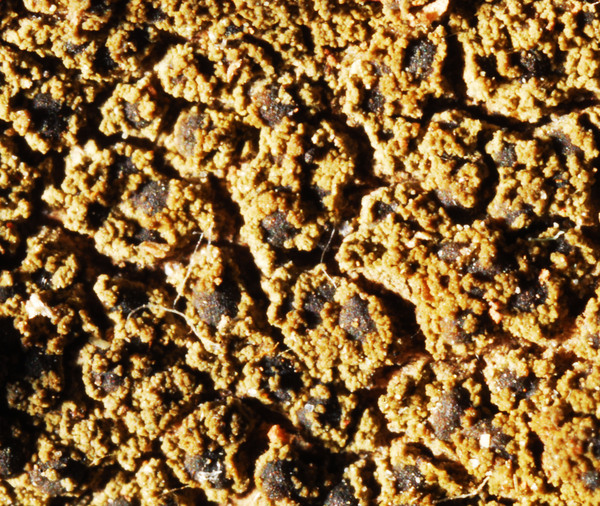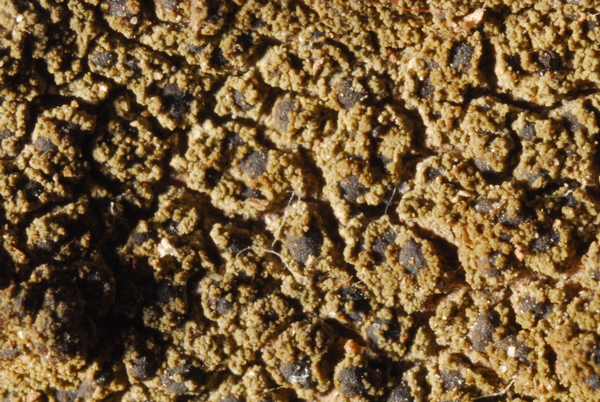Lecania crozalsiana H. Olivier
Bull. Acad. Intern. Géogr. Bot., 14: 205, 1905.
Synonyms: Bacidia crozalsiana (H. Olivier) Zahlbr.; Bilimbia crozalsiana (H. Olivier) B. de Lesd.
Distribution: S - Cal (Puntillo 1996, Puntillo & Puntillo 2004), Si (CLU 13422).
Description: Thallus crustose, episubstratic, whitish to pale brown, mostly powdery. Apothecia lecideine, up to 1.2 mm across, with a black, often whitish pruinose, flat disc, and a whitish, at first crenulate then smooth proper margin. Epithecium yellowish brown, K-; hymenium and hypothecium colourless; paraphyses simple or sparingly branched, rather lax, the apical cells slightly swollen. Asci 8-spored, cylindrical-clavate, surrounded by a gelatinous I+ blue coat, with a well-developed I+ blue tholus, an I+ darker blue tube and a well-developed ocular chamber, Bacidia-type. Ascospores (1-)3-septate, hyaline, ellipsoid or kidney-shaped, 20-23 x 4-6 µm. Photobiont chlorococcoid. Spot tests: thallus K-, C-, KC-, P-. Chemistry: thallus without lichen substances.Note: a very rare and poorly understood, humid subtropical lichen found on more or less isolated trees in warm-humid areas, exclusively Tyrrhenian in Italy. The generic placement is still an open problem. The record from the Province of Cuneo by Piervittori (2003) appears dubious to me, and is not accepted here. It is included in the Italian red list of epiphytic lichens as “Endangered” (Nascimbene & al. 2013c).
Growth form: Crustose
Substrata: bark
Photobiont: green algae other than Trentepohlia
Reproductive strategy: mainly sexual
Commonnes-rarity: (info)
Alpine belt: absent
Subalpine belt: absent
Oromediterranean belt: absent
Montane belt: absent
Submediterranean belt: absent
Padanian area: absent
Humid submediterranean belt: extremely rare
Humid mediterranean belt: extremely rare
Dry mediterranean belt: absent

Predictive model
Herbarium samples
Growth form: Crustose
Substrata: bark
Photobiont: green algae other than Trentepohlia
Reproductive strategy: mainly sexual
Commonnes-rarity: (info)
Alpine belt: absent
Subalpine belt: absent
Oromediterranean belt: absent
Montane belt: absent
Submediterranean belt: absent
Padanian area: absent
Humid submediterranean belt: extremely rare
Humid mediterranean belt: extremely rare
Dry mediterranean belt: absent

Predictive model
| Herbarium samples |
 Index Fungorum
Index Fungorum
 GBIF
GBIF




